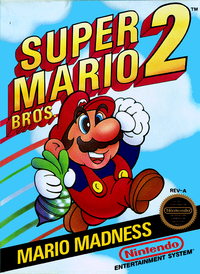| Site Notice |
|---|
|
Difference between revisions of "Super Mario Bros. 2"
m (Text replace - "Famicom Disk System" to "{{FDS}}") |
m (→External links) |
||
| Line 55: | Line 55: | ||
==External links== | ==External links== | ||
| − | * {{wp|Super Mario Bros. 2|Wikipedia | + | * {{wp|Super Mario Bros. 2|''Super Mario Bros. 2'' on Wikipedia}} |
| − | + | * {{sw|Super Mario Bros. 2|''Super Mario Bros. 2'' guide on StrategyWiki}} | |
| − | * {{sw|Super Mario Bros. 2|StrategyWiki | ||
{{Super Mario series}} | {{Super Mario series}} | ||
{{Classic NES series}} | {{Classic NES series}} | ||
{{Super Smash Bros. series}} | {{Super Smash Bros. series}} | ||
| + | |||
[[Category:Nintendo Entertainment System games]] | [[Category:Nintendo Entertainment System games]] | ||
[[Category:Nintendo Entertainment System Virtual Console games]] | [[Category:Nintendo Entertainment System Virtual Console games]] | ||
Revision as of 20:31, 20 January 2016
| This article is a short summary of Super Mario Bros. 2. Super Mario Wiki features a more in-depth article. |
| Super Mario Bros. 2 | ||||||||||||||
| スーパーマリオUSA | ||||||||||||||
| ||||||||||||||
| ||||||||||||||
| ||||||||||||||
| ||||||||||||||
|
Super Mario Bros. 2, also known in Japan as Super Mario USA, is a platformer video game released for the Nintendo Entertainment System in 1988 as the sequel to the original Super Mario Bros.. Unlike other Mario games, Super Mario Bros. 2 was not initially developed as a Mario game. It is actually a remake of the Famicom Disk System game Yume Kōjō: Doki Doki Panic due to the high difficulty of the original Super Mario Bros. 2 released in Japan.
Blurb
"Mario's back! Bigger and badder than ever before! This time it's a fierce action-packed battle to free the land of Subcon from the curse of the evil Wart. It's up to you, along with Mario, Luigi, Toad, and the Princess, to fight your way through bizarre multi-level worlds and find him! This time you've got a brand new kind of power—plucking power—and now anything you find can be a weapon. But beware! You've never seen creatures like these! Shyguys and Tweeters! Ninji and Beezos! And you've never had an adventure like this! Only cunning and speed can save you now..."
Story
One night, Mario has a strange dream where he sees a long stairway leading up to a door. When he opens the door, he sees a completely different world and hears a faint voice telling him that the land was cursed by Wart. As soon as the voice pleads Mario to help, a bolt of lightning suddenly flashes and causes Mario to wake up. He tells Luigi, Toad, and Princess Toadstool about his dream and they decide to go a nearby mountain for a picnic. While looking at the scenery they notice a small cave nearby and enter it. They see a long stairway strikingly similar to the one Mario saw in his dream and climb it. When the open the door at the top of the stairway, they see the same world that Mario had seen, much to their surprise.[1]
Gameplay
Due to Super Mario Bros. 2 being a redesign of Yume Kōjō: Doki Doki Panic, it has many elements not present in the original Super Mario Bros., such as the ability to pick up and throw enemies and objects and a life meter. However, it does have some power-ups similiar to the ones in the first game such as the mushrooms and the Starman.
At the start of each level, the player has to choose which character they want to play as. The playable characters are Mario, Luigi, Toad, and Princess Toadstool. They each have slightly different jumping power, with Luigi being able to jump the highest and Toad having the least jumping power. They also having varying speeds in picking up items, with Toad being the quickest and Princess Toadstool being the slowest.
There are seven worlds in Super Mario Bros. 2. The first six worlds each have three levels while the seventh world has two. At the end of most levels, the player has to fight Birdo and another boss at the end of each world.
Other releases
Super Mario Bros. 2 has been re-released several times since its initial release. It was one of the playable games on the Nintendo PlayChoice-10 arcade machine and was eventually released as a Famicom Disk System in Japan under the title Super Mario USA. A remake of Super Mario Bros. 2 was also included as part the Super Mario All-Stars compilation game for the Super Nintendo, as well as Super Mario All-Stars + Super Mario World and Super Mario All-Stars - 25th Anniversary Edition. Another remake called Super Mario Advance was released for the Game Boy Advance in 2001. The original version was made available on the Wii's Virtual Console in 2007.
References
- ↑ Super Mario Bros. 2 instruction booklet, pages 3-4
External links
|
|
| ||||||
| ||||||


